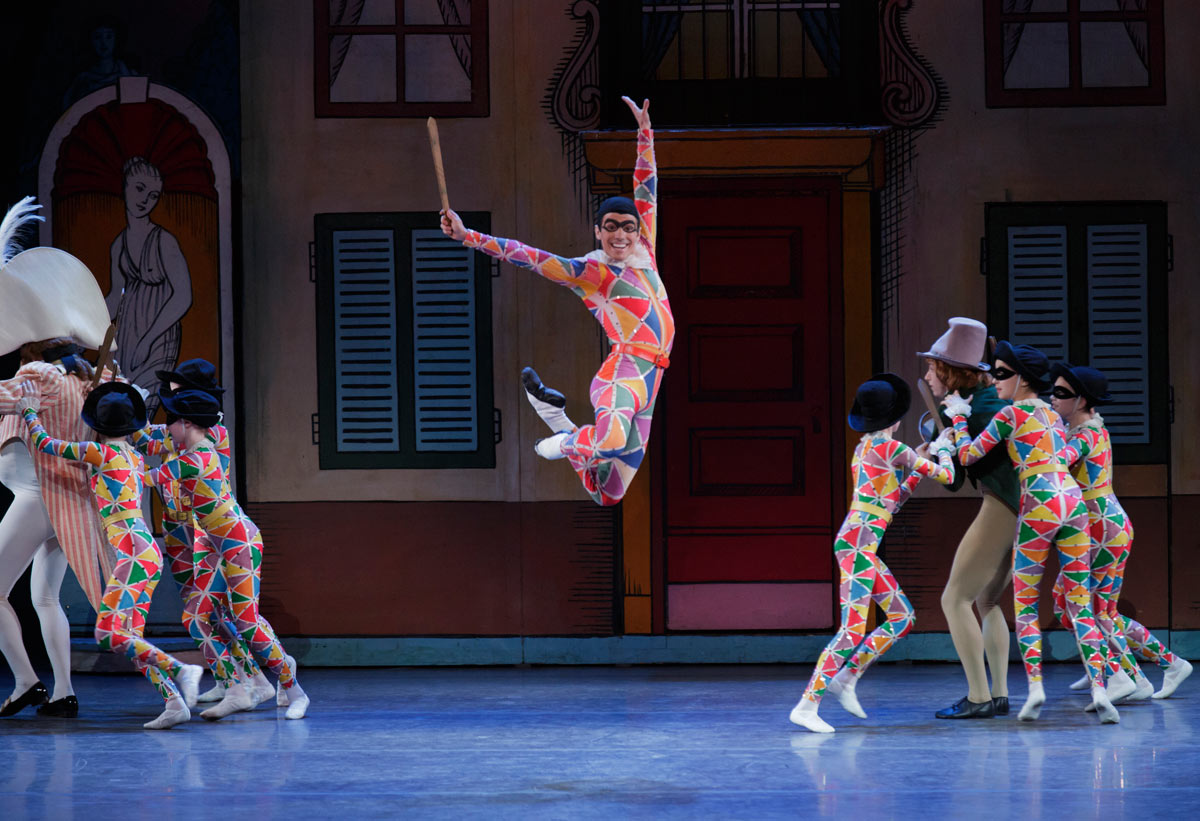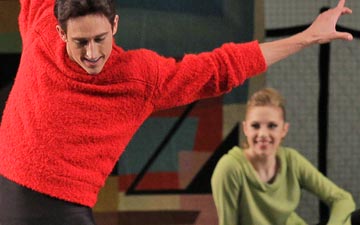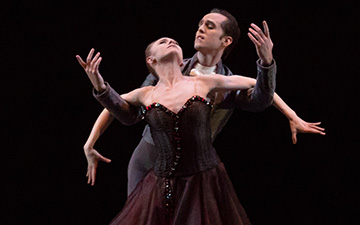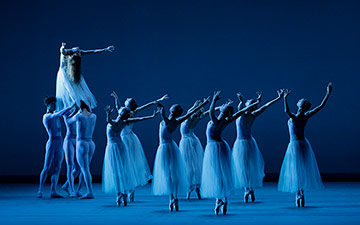
© Paul Kolnik. (Click image for larger version)
New York City Ballet
Harlequinade, N.Y. Export: Opus Jazz
New York, David H. Koch Theater
8 October 2015
www.nycballet.com
N.Y. Export: Opus Jazz is frequently tagged as the post-“West Side Story” “sneaker ballet” and one can see why. Dancers slink and swivel in plimsolls, sinking their hips into jazz (in the case of Opus, a score by Robert Prince). But even the abbreviated West Side Story Suite, as much fun as it is, can feel a touch dated. Unencumbered by concrete narrative (though there are whispers and episodes), Opus Jazz stretches wider and encompasses more than a musical could, not just choreographically but in atmosphere and contemporaneity. Opus is undeniably of its time, but much of what it tries to communicate – the irreverence and freedom of youth, the impersonal disconnect of modernity – breathes more freely in the abstract, and still resonates, some 57 years later.
While Opus stars 16 dancers, it’s hard not to focus on Georgina Pazcoguin, whose timing and crispness emanate a sensational newness, a generational excitement. Nervy, rhythmic, and jaunty, Pazcoguin tips her hips to the horns and manages both to envelop and expel the music through her body. It’s hard not to think of “Funny Face,” in which Audrey Hepburn dashes around a Parisian nightclub with exaggerated, spiky moves in a black cat burglar outfit. Robbins was tapping a zeitgeist: “Funny Face” came out in 1957, the same year as WSS.

© Paul Kolnik. (Click image for larger version)
In the moody movement Passage for Two, Ashley Laracey and Craig Hall perform a duet that sees two people have a brush with intimacy, and nothing more: no wave, no goodbye, no nothing, certainly no morning after. It starts sexily, with an elegant game of footsie. The coolness is confident, sexually independent, modern. There are no courtly rituals here. This is sex as a cup of coffee, as a piece of gum, as a transient, uncomplicated, anonymous thing. In one astonishing “lift,” Hall, with his back to the audience, balances Laracey on his upper back – both of them with their arms stretched out – the only thing keeping her from falling is the friction between their t-shirts.
Opus was created when, to the conservative set, jazz, beatniks, poets and the rumblings of street dance were seen as dangerous things, the corruption of a generation. While there had been renegades earlier in the 20th century, it took nearly 60 years before a separate, identifiable youth culture with its own modus operandi became a culture not of outcasts but of something more mainstream, more obvious. Opus was created on the cusp of this, and because kids will always be kids, its joyful arrogance remains fresh today.
Harlequinade is an entirely different affair as a production, though at its heart, it is about youth wanting to break with tradition. Balanchine created the two act ballet as a sort of tribute to Petipa: “I have attempted to remain faithful to the spirit of Petipa’s dances and drama without reproducing any of the actual steps of his time. Who, in fact, remembers them?” [Balanchine’s Complete Stories of the Great Ballets c. 1977 page 291]
Based on the commedia dell’arte story, Harlequinade is a comedic ballet that results in the eventual marriage of Harlequin and Colombine, whose romance is initially thwarted by Harlequin’s empty pockets and Colombine’s father’s disapproval. Rouben Ter-Arutunian’s set mimics a 19th century paper theater, and the costumes – also by Ter-Arutunian – are pleasantly garish, like something off the Meadham Kirchoff runway. Featuring a delightfully bumbling fool with a Humpty Dumpty belly (Robert La Fosse) , a dopey Pierrot (Daniel Ulbricht) and a twinkling good fairy (Emilie Gerrity), Harlequinade is popular with the children – who aren’t just in the audience but on stage, taking up a good portion of the second act with countless divertissements.

© Paul Kolnik. (Click image for larger version)
One expects Harlequinade to be a fairly routine and dramatically flat affair. But Tiler Peck and Joaquin De Luz – as Colombine and Harlequin – take it to another level. How such a simplistic, twee ballet can be turned into something of real romance takes depth, character and a developed partnership. Peck’s Colombine is sweet, cute, pretty and flirty. De Luz’s Harlequin is devoted and adoring. Maybe it’s De Luz’s hyper-attentive partnering, maybe it’s their commitment to eye contact, or maybe it’s just plain chemistry, and De Luz and Tiler have it. When Peck arches back into the nape of De Luz’s neck, she embodies the infatuated girl on the cusp of a deep love. The two are comfortable, yet exude a believable frisson between two of the oldest stock characters in theatre.
It helps that they both have rock-solid technique and razor-sharp musicality. Peck could be merely doll-like, but her warmth gives the role a believable humanity. She is balletic but also naturalistic, her neck and epaulement never strained, but always poised. De Luz’s lofty (really lofty) leaps are those of a teenager in love, his smile winning. Peck and De Luz prove that great technique can reap rewards beyond virtuosity, freeing the dancer up to act.
The real litmus test of success came from a couple in the orchestra stalls, well into their 70s, who held hands and mimicked the pert kisses Colombine and Harlequin exchange throughout the ballet, pecking at each other like two little birds in love.

















You must be logged in to post a comment.